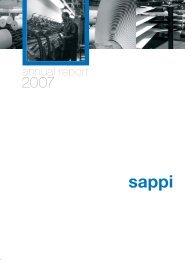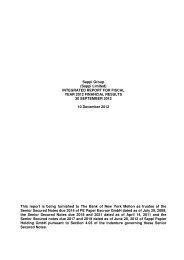SAPPI LTD (SAP) 6-K
SAPPI LTD (SAP) 6-K
SAPPI LTD (SAP) 6-K
Create successful ePaper yourself
Turn your PDF publications into a flip-book with our unique Google optimized e-Paper software.
Note 8•Depreciation, amortisation and impairment charges<br />
The following shows the split of the Company’s depreciation, amortisation and impairment charges for the years ended 31 December:<br />
2007 2006 2005<br />
Straight-line depreciation<br />
Other intangible assets 1,378 1,381 1,174<br />
Buildings 11,661 4,882 9,714<br />
Machinery and equipment 78,984 49,046 62,802<br />
Other property, plant and equipment 3,639 3,712 3,927<br />
Total 95,662 59,021 77,617<br />
Impairment charges and reversal of impairment charges<br />
Goodwill 83,000<br />
Buildings (30,955) 4,100 34,700<br />
Machinery and equipment (120,045) 15,900 133,300<br />
Total (151,000) 20,000 251,000<br />
Straight-line depreciation, impairment charges<br />
and reversal of impairment charges, total (55,338) 79,021 328,617<br />
The Company prepares impairment test calculations annually. In accordance with IAS 36 “Impairment of Assets”, the carrying amount of asset items or so<br />
called cash generating units (CGUs) are evaluated for indications of impairment. If there are indications of impairment of an asset item or the CGU the<br />
recoverable amount of the asset item or CGU shall be estimated. The Company is tested as one cash generating unit. The recoverable amount is based<br />
principally on estimated future cash flows.<br />
The recoverable cash flows of the CGU are based on 5-year projections and consequent cash flows growing at a fixed annual growth rate. The key<br />
assumptions used in the projections are management’s estimates and estimates from Pöyry Forest Industry Consulting Ltd. The key factors affecting the<br />
projections are the development of the average paper and board prices, delivery volumes, foreign exchange rates, and capacity utilisation rates, the cost<br />
development of key raw materials such as wood, pulp, chemicals and energy as well as the development of personnel costs and other fixed costs. In the<br />
impairment tests the cash flows consequent to the 5-year projected cash flows are based on a 2 per cent fixed annual growth rate, which corresponds to the<br />
realised long term growth of the CGU.<br />
Furthermore, the average values for the key assumptions (price, volume, variable costs) during the projection period have been used as starting point. The<br />
starting point for fixed costs is the projected costs for the fifth year. Both the future cash flows as well as the discount rate are calculated after tax e.g. the<br />
consequent discounted cash flows and values in use are before tax as required in IAS 36. The after tax WACC used in the impairment tests was 7.74%,<br />
7.09% and 6.74% in the years ended 31 December 2007, 2006 and 2005, respectively.<br />
In 2005, mostly because of higher pulp prices, increasing energy costs and reduced price estimates for the next 5 years the recoverable amount had fallen<br />
below the carrying amount of the CGU, an impairment charge of EUR 251,000 was recognised in the Company’s combined income statement. In 2006,<br />
mostly because of higher SW pulp price estimates and lower magazine paper price estimates for the next 5 years, an additional impairment charge of EUR<br />
20,000 was recognised in the Company’s combined income statement. In 2007, primarily because of a significant increase in the estimated long term sales<br />
prices of wood free coated paper, uncoated paper and magazine paper, partially resulting from a decrease in excess paper capacity during the year, the<br />
Company recognised reversal of impairment losses previously recognised on long lived assets other than goodwill in the amount of EUR 151,000.<br />
80
















